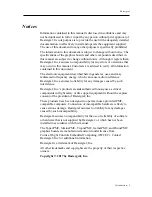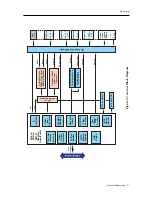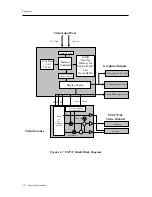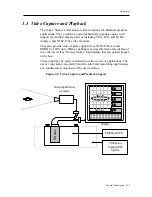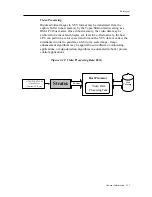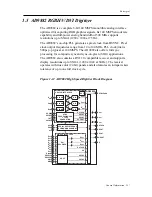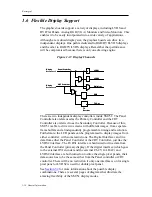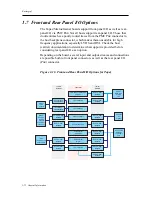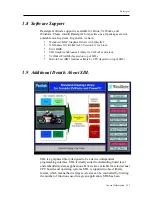
Rastergraf
1-10 General Information
1.2.2 Detailed Description
The SM731 delivers full-featured 3D, a unique memory architecture
designed to enhance 3D/2D performance, enhanced multi-display
capabilities, and Motion Compensation for DVD. Software support is
available under Windows 2K/XP and Linux/XFree86.
A robust 128-bit Drawing Engine provides excellent 2D performance. The
Drawing Engine supports 3 ROPs, BitBLT, transparent BLT, pattern BLT,
color expansion, line draw and Alpha blending. The Host interface Unit
allows support for PCI up to 66 MHz.
The SM731 incorporates an IEEE Floating Point Setup engine as well as a
full-featured 3D rendering engine. The 3D engine pipeline was designed
to operate in a balanced manner, allowing setup of 6 million triangles per
second (125MHz core frequency) and rasterization of 125 Mpix/s. The
dual pipe Texture engine can output 250 million Texels per second.
Among other features, SM731 natively supports MIP mapping, Alpha
blend, Specular highlights and Fog, Stencil planes, W buffer and fog,
Bump Mapping, and Z engine.
The SM731 integrates 16 Mbytes of on-board SGRAM (SDR) over a 64-
bit memory bus operating at up to 150 MHz. The 1.2 GB/sec peak
bandwidth available allows concurrent support of large displays and other
processing functions at optimum performance.
SM731 can drive two independent digital displays or simultaneously drive
LCD, CRT and TV displays. It also incorporates two 112 MHz Max pix
clock LVDS channels that can drive two separate panels or a single
high-resolution panel (up to UXGA). Support for all ACPI power states is
provided. A high quality TV encoder, VGA Core, LCD Backend
Controller and 235 MHz RAMDAC are incorporated as well.
The SM731's Motion Compensation block, Video Processor block, and
Video Capture Unit provide superior video quality for real-time video
playback and capture. When combined with performance CPUs, the
Motion Compensation block allows full frame playback of DVD video
content without the need for additional hardware. The Video Processor
supports multiple independent full screen, full motion video windows with
overlay. Each motion video window uses hardware YUV-to-RGB
conversion, scaling, and color interpolation. When combined with multi-
view capabilities of the chip, these independent video streams can be
output to each of two display devices and bilinear scaled to support
applications such as full screen display of local and remote images.
Содержание Duros
Страница 8: ......
Страница 13: ...Rastergraf General Information 1 1 Chapter 1 General Information...
Страница 40: ......
Страница 41: ...Rastergraf Specifications 2 1 Chapter 2 Specifications...
Страница 61: ...Rastergraf Connector Pinouts and Cable Information 3 1 Chapter 3 Connector Pinouts and Cable Information...
Страница 105: ...Rastergraf Installing Your Rastergraf Graphics Board 4 1 Chapter 4 Installing Your Rastergraf Graphics Board...
Страница 133: ...Rastergraf Programming On board Devices and Memories 5 1 Chapter 5 Programming On board Devices and Memories...
Страница 136: ...Rastergraf 5 4 Programming On board Devices and Memories...
Страница 137: ...Rastergraf Programming On board Devices and Memories 5 5...
Страница 138: ...Rastergraf 5 6 Programming On board Devices and Memories...
Страница 139: ...Rastergraf Programming On board Devices and Memories 5 7...
Страница 140: ...Rastergraf 5 8 Programming On board Devices and Memories...
Страница 141: ...Rastergraf Programming On board Devices and Memories 5 9...
Страница 142: ...Rastergraf 5 10 Programming On board Devices and Memories...
Страница 143: ...Rastergraf Programming On board Devices and Memories 5 11...
Страница 164: ......
Страница 165: ...Rastergraf Troubleshooting 6 1 Chapter 6 Troubleshooting...




